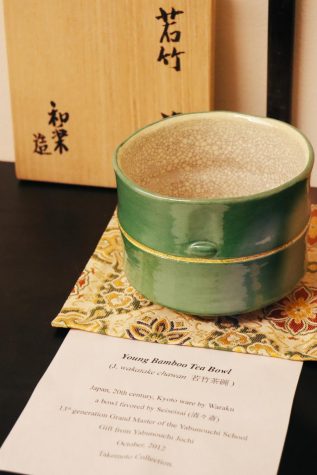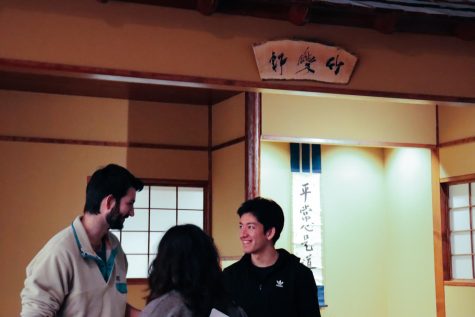The art of tea
February 16, 2023

The Chikurakken, commonly known as the Tea Room on campus, literally translates to “bring in some bamboo and enjoy its cool wind and shadows.” Located in Olin’s east wing, the Chikurakken opened in the fall of 2009, featuring tatami flooring, a small tea preparation area and an alcove to display artwork. It was inspired by the requests of countless people to Akira R. Takemoto.
Takemoto-sensei, of the Department of Foreign Language and Literature, arrived at Whitman in 1983 to teach Nihongo (Japanese), but he had always been interested in tea. Over time, he began teaching chanoyu – the Japanese art of tea – to others.
“Before this tea room existed, I took tatami mats to different spaces and created simple tea rooms to demonstrate the art of serving tea. I created tea spaces in Jewett, Hunter, the foyer of Cordiner Hall, different classrooms in Olin and Maxey and in the three different Japanese language houses,” Takemoto-sensei said.
First, Takemoto-sensei, with one of his students, tried building a three mat tea room at the Sheehan Gallery, as carrying out mats all over campus was difficult. This new room remained one of the outdoor spaces for over ten years. Finally, when the current space opened up, Takemoto-sensei proposed moving the tea room to Olin Hall. He wasn’t sure it would work out, so he had backup plans to move the tea room to his house.
Due to Takemoto-sensei’s interest in tea, he has always wanted to add a class on tea or Japanese aesthetics.
“There are many ways to introduce the arts, aesthetics and traditional literature of Nihon (Japan). A person can introduce students to texts, but it’s also fun to do it physically,” Takemoto-sensei said. “I enjoy performing poems. Indeed, some literary works can be best appreciated when they are read or chanted aloud. Even though you may not understand the meaning of all the words, it can be fun to hear them read and performed. That’s been my way of getting excited about a literary work. What I do in the tea room, then, is simply heat water and serve a bowl of tea to friends.”

Irene Tsai has taken many classes in the tea room. She expressed that the presence of a traditional tea room on campus is an honor and privilege.
“I think having the opportunity to explore the tea room is what makes Whitman more unique in terms of their Asian studies and Japanese department,” Tsai said. “I have many fond memories in the Whitman tea room, as it was one of the first rooms I saw when I first entered Whitman as a first-year. I remember Takemoto-sensei, who was my pre-major advisor, just blowing my mind and deconstructing everything I knew about the Japanese language, and I remember leaving the tea room with a new outlook on the Japanese language.”
Tsai believes that anyone who has the chance should stop by the Tea Room, even if only for a few minutes.
“The tea room is a unique experience that you can’t get in many places besides actually being in Japan. It is an amazing way to learn more about traditional Japanese arts [with displays of traditional art styles]. It symbolizes the dedication the school has towards Asian and Japanese studies and for more Asian representation on campus. The unique experience of just sitting in the tea room space, or attending a tea ceremony session with Takemoto-sensei, is an experience you will never regret or forget,” Tsai said.
First-year from Japan Konon Matsumoto shared that the tea ceremony is a Japanese tradition where the host prepares the tea as a form of hospitality, while the guest enjoys the tea and the atmosphere that the host creates. It is a way of getting out of the daily-life routine away from the business and enjoying the moment of peace and respect.
“I believe that the presence of a tea room is a great way to introduce some Japanese majors on tea and more on Japanese culture, as it’s not only the language itself, but also learning the culture by immersing themselves,” Matsumoto said.
To learn more about the tea room, contact takemoto@whitman.edu or visit the east wing of Olin during afternoons.





